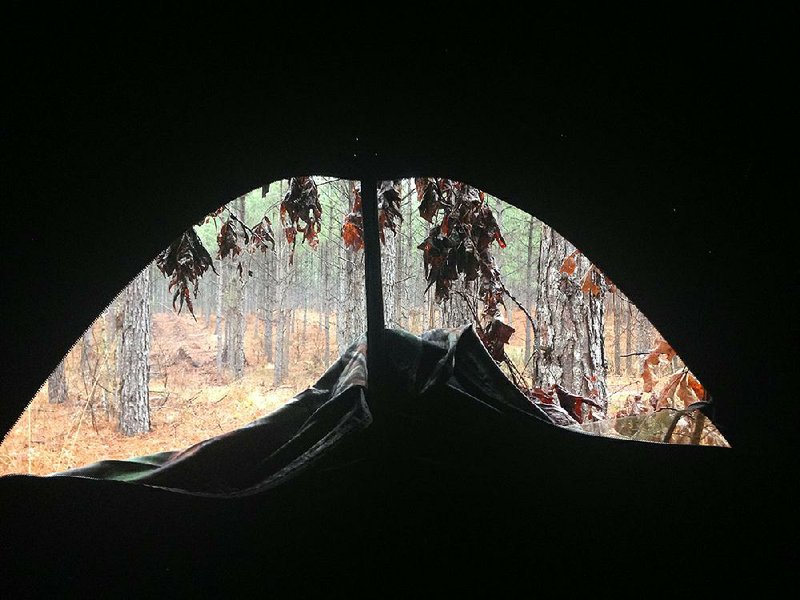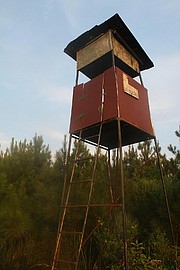As muzzleloader deer season begins, many hunters are behind on deer camp chores, but you have time to hunt and work.
Excessive heat and humidity, horseflies, chiggers and ticks discouraged many hunters from tending to basic but essential woods chores at the end of summer. Nevertheless, safety is the paramount consideration when hunting, and hunters must ensure that their gear is in working order.
If you left a climbing stand in a tree over the winter, make sure it is secure before you put your weight on it. Straps and cables should be tight and in good repair. Highly experienced hunters climb onto hanging stands every year without checking for damage and degradation and experience disastrous results.
With the high-quality safety gear that is available, there is no excuse for ascending a tree without a full-body harness and a lifeline. A booted foot can slip on a metal ladder rung, or a climbing stand platform can lose its grip on a tree, sending a hunter plummeting to the ground with broken limbs, paralysis or death. A high-quality harness and lifeline will prevent you from hitting the ground. You can also buy a descender device that will lower you to the ground at a slow, controlled rate from as high as 25 feet.
If you hunt from a box stand, make sure ladder-rung welds are strong. If your stand has wooden steps, replace rotten steps or rungs.
If you hunt from leaning stands or metal tripods, make sure all nuts and bolts and ratcheting straps are secure and tight, and that chains are secure.
Ideally, all of these inspections and repairs were done before Saturday, when muzzleloader season began. If you haven't tended to high-risk suspended platforms, don't risk it. Hunt from the ground until you ascertain it is safe. A pop-up blind is an excellent way to hunt from a concealed position with a muzzleloader.
As I sit in my stand on this glorious Saturday morning, I see much work still to do, not the least of which is on the stand itself. I am near to completing its third renovation.
When I obtained the stand, the sides were composed of rotten 1/2-inch plywood. I replaced it with new 1/4-inch plywood that my son covered with multiple coats of a deep, maroon outdoor paint. It blended into the woods very well.
Over the years, the siding rotted, panel by panel. I replaced one side with red corrugated plastic. It looked close to the existing red in the store, but in the woods, it is garish. Deer have grown used to it, but they still look at it frequently.
All the other sides have finally rotted away, forcing me to replace them, as well. This time I bought sheets of dark gray. One side is peppered with black specks. It vanishes in the piney landscape. I like it so much that I cut new panels to cover the horrid red panel. All that's left is the door and a front half-panel. They are beneath the stand. My cordless drill is in my four-wheeler basket. I'll take care of that loose end when I take a break from hunting.
I also have a lot of clearing to do. Muzzleloader season seems a horrible time to cut and whack brush and saplings, but it really isn't. I use a mechanical pole saw to nip small horizontal branches and sweet gum saplings. It is very quiet and efficient. I also have on hand a gas-powered trimmer with a brush-cutting blade for some of the bigger stuff, and also a small chainsaw.
They are noisy, but my experience is that noise doesn't deter deer if it doesn't last too long. I hunt in a working industrial forest. The sounds of chainsaws, skidders and other equipment are common. Deer are used to them and are not adversely conditioned to them. Years ago, Keith de Noble of Little Rock, an accomplished bowhunter, said deer love to use newly cut lanes in piney woods, and that they often use them hours after they are cut.
Remote cameras will tell you the times when deer appear in certain areas. You can minimize the risk of disturbing them by working at times when cameras do not photograph deer.
Fortunately, most of the big jobs, like rejuvenating overgrown lanes and extending lanes, can wait until winter. The work is easier then because shrubs and bushes are defoliated, making them less bulky, less dense and easier to move aside and stack after cutting. The strenuous work also is pleasant in cold weather, when biting bugs are not present.
Don't be afraid to move a stand if you discover a better spot is nearby. Years ago, when I was a member of East End Hunting Club, I had a tripod stand overlooking a small food plot at the edge of an electrical transmission line right of way. A mature buck busted me on that stand on opening day of the 2008 modern gun deer season. The buck continued to visit, but he always peered at the stand from the safety of the thicket edge.
After about a week of peek-a-boo, I crept in one night and erected a lean-to stand two rows back in the pines, but I left the tripod in place. I returned two days later for a late afternoon hunt. About a dozen does filtered into the food plot. Near sunset, the buck appeared at the edge of the thicket. Seeing that the tripod was unoccupied, he trotted into the food plot to chase a doe.
I got him.
Sports on 10/20/2019


